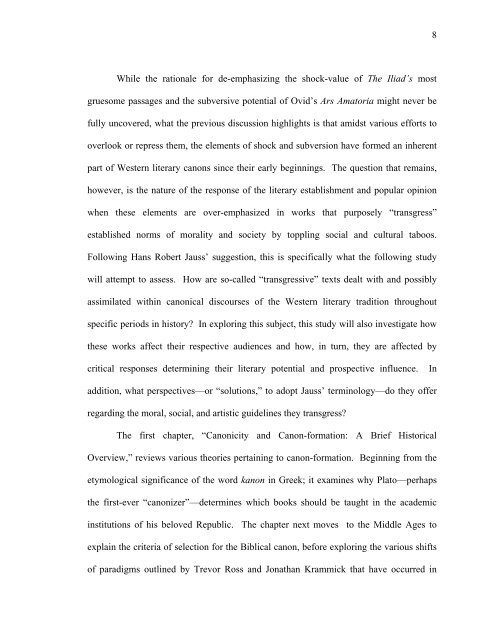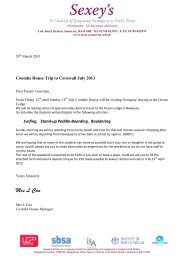- Page 2 and 3: ABSTRACT This thesis examines the r
- Page 4 and 5: TABLE OF CONTENTS Acknowledgments 4
- Page 6 and 7: INTRODUCTION If one looks at the mo
- Page 10 and 11: following centuries due to the chan
- Page 12 and 13: favorably by its contemporaries on
- Page 14 and 15: REVIEW OF SECONDARY SOURCES This in
- Page 16 and 17: Whereas these historical accounts a
- Page 18 and 19: a framework under which transgressi
- Page 20 and 21: Chapter 1 CANON-FORMATION, TRANSGRE
- Page 22 and 23: amongst so-called “minorities”
- Page 24 and 25: elonged to—these works were at on
- Page 26 and 27: that person “is driven over the g
- Page 28 and 29: the third century. At Yavneh the sc
- Page 30 and 31: especially at the dawn of the twent
- Page 32 and 33: theater-goers (Stallybras et al. 84
- Page 34 and 35: emergence of new genres in literatu
- Page 36 and 37: have been produced to please the ma
- Page 38 and 39: Literature remained a favored means
- Page 40 and 41: poet lies in his powerful and beaut
- Page 42 and 43: specifically, it rebelled against t
- Page 44 and 45: according to Johnson, “discolored
- Page 46 and 47: while at the same time, establishin
- Page 48 and 49: There is no reason to assume that t
- Page 50 and 51: isolated case in the reception of l
- Page 52 and 53: During the period of revision of th
- Page 54 and 55: Henry Louis Gates Jr. It is only by
- Page 56 and 57: that remain canonical throughout th
- Page 58 and 59:
academia, and thus participate acti
- Page 60 and 61:
Chapter 2 SHOCK, SCANDAL, AND SUBVE
- Page 62 and 63:
As is the case with canonical disco
- Page 64 and 65:
Although in this excerpt Foucault
- Page 66 and 67:
eplaces language, where language be
- Page 68 and 69:
that one distinguishable characteri
- Page 70 and 71:
Enlightenment period. In the case o
- Page 72 and 73:
transgressive artworks and their re
- Page 74 and 75:
sport of them. Nevertheless, it mai
- Page 76 and 77:
a practice or belief, or a set ther
- Page 78 and 79:
epressed instinctual drives stored
- Page 80 and 81:
Within the perspective enunciated a
- Page 82 and 83:
and high culture as did the Marquis
- Page 84 and 85:
“interrogators,” those who subv
- Page 86 and 87:
(sometimes, of the state itself),
- Page 88 and 89:
taking action. In other words, by b
- Page 90 and 91:
consequently, loses its transgressi
- Page 92 and 93:
Chapter 3 WORLDS COLLIDE: CULTURAL
- Page 94 and 95:
sub-genre of literature that was co
- Page 96 and 97:
case of the late eighteenth century
- Page 98 and 99:
As a reaction to this “democratiz
- Page 100 and 101:
To a certain extent, the Gothic is
- Page 102 and 103:
101 To understand the controversy s
- Page 104 and 105:
historical value was intensively sc
- Page 106 and 107:
“dialogue,” rather a unilateral
- Page 108 and 109:
egarding cultural and political ide
- Page 110 and 111:
Watt argues that the latter conside
- Page 112 and 113:
and the name of its author was reve
- Page 114 and 115:
contextualization of their work and
- Page 116 and 117:
critical acclaim by following the p
- Page 118 and 119:
Radcliffe’s novels (245), a trans
- Page 120 and 121:
efficiency of the legal system. As
- Page 122 and 123:
controversy is finally dispelled, t
- Page 124 and 125:
123 The distinction between Radclif
- Page 126 and 127:
125 Even though The Monk was immens
- Page 128 and 129:
ejection of inherited dogma. This i
- Page 130 and 131:
that with regard to such material a
- Page 132 and 133:
they represented wanted to diffuse
- Page 134 and 135:
different generations of readers th
- Page 136 and 137:
elements—and its Preface, where t
- Page 138 and 139:
the unfavorable conditions under wh
- Page 140 and 141:
addition, following Michelle A. Mas
- Page 142 and 143:
suppress his passionate nature resu
- Page 144 and 145:
its tenure as a work of transgressi
- Page 146 and 147:
145 In recent history, no book has
- Page 148 and 149:
147 Bret Easton Ellis’ American P
- Page 150 and 151:
depend on the individual, on his or
- Page 152 and 153:
transgressions. Ironically, even th
- Page 154 and 155:
While this episode can be perceived
- Page 156 and 157:
which he/she participates as well.
- Page 158 and 159:
In American Psycho, Ellis makes sim
- Page 160 and 161:
are responsible for provoking the m
- Page 162 and 163:
161 Even so, as outlined earlier, t
- Page 164 and 165:
ecome inescapably appealing. The st
- Page 166 and 167:
overwhelming, or, in more extreme c
- Page 168 and 169:
Although Murphet’s appraisal of t
- Page 170 and 171:
argued above, the latter produces q
- Page 172 and 173:
“civilized” man is indeed no st
- Page 174 and 175:
males 25 . Such interrogations only
- Page 176 and 177:
liberal capitalism, two trends that
- Page 178 and 179:
type of laughter that would lead ho
- Page 180 and 181:
outburst that characterized the rel
- Page 182 and 183:
she chooses to be atypical by censu
- Page 184 and 185:
consumption, no matter how perverte
- Page 186 and 187:
asic material satisfaction but for
- Page 188 and 189:
to be “committed.” The question
- Page 190 and 191:
“serious” literature as prescri
- Page 192 and 193:
191 As a satire, American Psycho do
- Page 194 and 195:
Batailles, Georges. Le Bleu du ciel
- Page 196 and 197:
Fortier, Frances. “L’esthétiqu
- Page 198 and 199:
Johnson, Samuel. “From Lives of t
- Page 200 and 201:
Poe, Edgar Allan. “The Philosophy
- Page 202 and 203:
Thoré. Théophile. “New Tendenci



